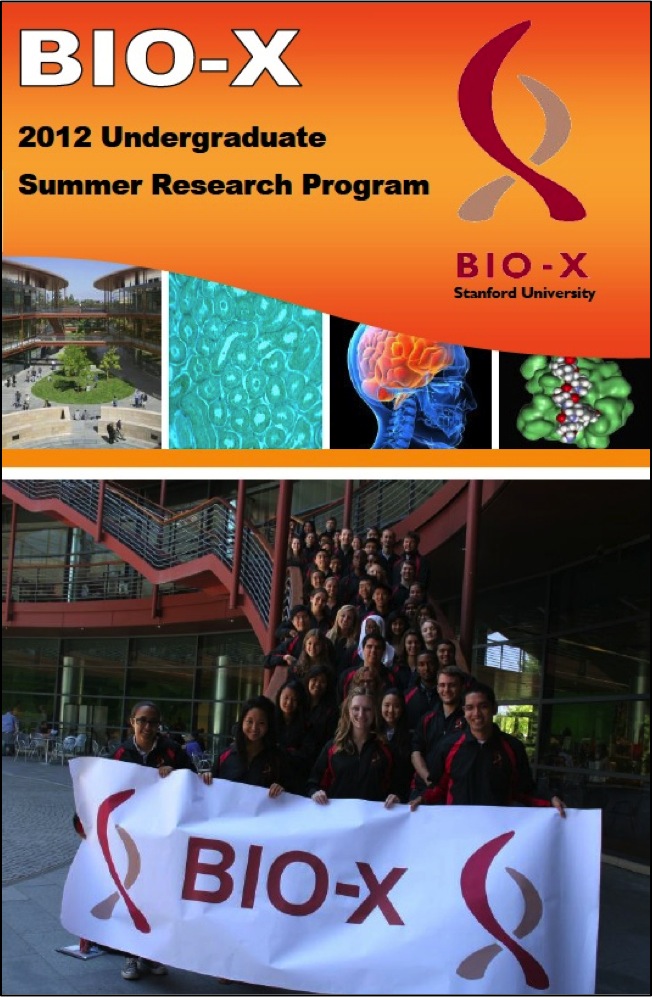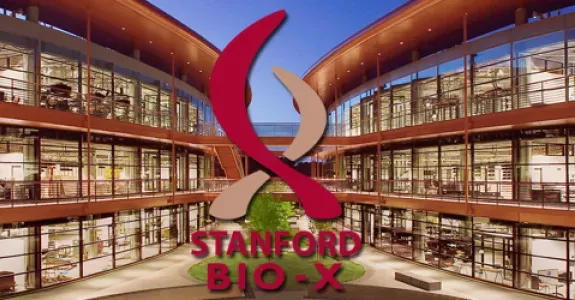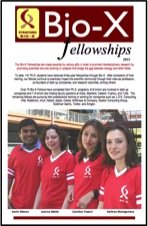
Welcome to the biweekly electronic newsletter from Stanford Bio-X for members of the Bio-X Corporate Forum. Please contact us if you would like to be added or removed from this distribution list, or if you have any questions about Stanford Bio-X or Stanford University.
Seed Grants
 SEED GRANTS FOR SUCCESS - Stanford Bio-X Interdisciplinary Initiatives Program (IIP)
SEED GRANTS FOR SUCCESS - Stanford Bio-X Interdisciplinary Initiatives Program (IIP)
The Bio-X Interdisciplinary Initiatives Program represents a key Stanford Initiative to address challenges in human health. The IIP awards approximately $3 million every other year in the form of two-year grants averaging about $150,000 each. From its inception in 2000 through the fifth round in 2010, the program has provided critical early-stage funding to 114 different interdisciplinary projects, involving collaborations from over 300 faculty members, and creating over 450 teams from five different Stanford schools. From just the first 4 rounds, the IIP awards have resulted in a 10-fold-plus return on investment, as well as hundreds of publications, dozens of patents filed, and most importantly, the acceleration of scientific discovery and innovation.
In 2012, Stanford Bio-X selected 23 new seed grant projects as the winners of the 6th round. Please go here to view the list of awardees, along with the titles of their projects and the abstracts of the research. Competition was intense as the awardees were chosen from 118 Letters of Intent (LOIs). Selection criteria included innovation, high-reward, and interdisciplinary collaboration. (To view the 114 other IIP projects that have been funded from the first 5 rounds, please click here.) In addition, SANOFI has also funded 4 new Bio-X IIP Seed Grant projects from round 6!
On February 25, 2013, Stanford Bio-X held its latest annual IIP Seed Grant Symposium at the Clark Center. It was attended by over 150 people, and the symposium included 8 podium presentations and 116 poster presentations. The podium talks represented research from a wide array of fields (such as gene delivery to interactive gaming in biology to tele-robotic systems to stem cells to hedgehog signal transductions and more), with each project exemplifying the Stanford Bio-X mission of crossing boundaries to bring about interdisciplinary research and solutions in the field of life bioscience. The talks for this symposium are posted here. To view previously recorded talks, please go here.
SAVE THE DATE: the next Bio-X IIP Symposium will be taking place on August 26, 2013! Please see below under "EVENTS" for the oral presentation agenda.
We are cultivating and are highly successful in building meaningful collaborations with numerous corporate colleagues. New collaborations through our seed grant projects are highly encouraged. To learn about how to get involved, please contact Dr. Hanwei Li or Dr. Heideh Fattaey.
Fellowships
Every year, graduate students and postdoctoral scholars of Bio-X affiliated faculty are highly encouraged to apply for the Bio-X Fellowships, which are awarded to research projects that are interdisciplinary and utilize the technologies of different fields to solve different biological questions. Students are encouraged to work collaboratively with professors of different departments, thus creating cross-disciplinary relationships among the different Stanford schools. Our fellows have conducted exciting research, resulting in publications in high-impact journals and have been offered excellent positions in industry and academia. To date, Stanford Bio-X has a total of 152 Fellows.
On June 26th, Bio-X held its annual Bio-X Fellows Symposium, where there were four 15-minute oral presentations followed by one-minute spiels from current fellows. The 25 newest fellows selected this year were also announced, and about 100 attendees came to the symposium. Please click on the "Bio-X Fellows Symposium" link above for the agenda and titles of the talks, and on the icon of the brochure above for the updated and latest Bio-X Fellowships brochure.
To view the numerous projects that have been awarded over the years, please click here.
 BIO-X UNDERGRADUATE SUMMER RESEARCH PROGRAM
BIO-X UNDERGRADUATE SUMMER RESEARCH PROGRAM
The Bio-X Undergraduate Summer Research Program supports undergraduate research training through an award designed to support interdisciplinary undergraduate summer research projects. The program is an invaluable opportunity for students to conduct hands-on research, learn how to carry out experiments in the laboratory, and develop the skills to read and analyze scientific literature.
This program is eligible to Stanford students who want to work in the labs of Bio-X affiliated faculty. To date, 176 students have been awarded the opportunity to participate in the Bio-X Undergraduate Summer Research Program. This summer is Stanford Bio-X's 8th round of USRP.
Participating undergraduates are also required to present poster presentations on the research that they've conducted during the program. Please click here for title lists of past posters that our undergraduates have presented.
Many fruitful collaborations and relationships have been established with industry through fellowships. Please contact Dr. Hanwei Li or Dr. Heideh Fattaey if you'd like to learn more about how to get involved with these fellowship programs.
News
 ‘Dead’ gene comes to life, puts chill on inflammation, researchers find
‘Dead’ gene comes to life, puts chill on inflammation, researchers find
Bio-X Affiliated Faculty Howard Chang
A gene long presumed dead comes to life under the full moon of inflammation, Stanford University School of Medicine scientists have found. The discovery, described in a study published July 23 in eLife, may help explain how anti-inflammatory steroid drugs work. It also could someday lead to entirely new classes of anti-inflammatory treatments without some of steroids’ damaging side effects. Chronic inflammation plays a role in cancer and in autoimmune, cardiovascular and neurodegenerative diseases, among others. Anti-inflammatory steroid drugs are widely prescribed for treating the inflammatory states that underlie or exacerbate these conditions. “Inflammation tells your body something is wrong,” said the study’s senior author, Howard Chang, MD, PhD, professor of dermatology at Stanford and the recipient of an early career scientist award from the Howard Hughes Medical Institute. “But after it does its job of alerting immune cells to a viral or bacterial infection or spurring them to remove debris from a wound site, it has to get turned off before it causes harm to healthy tissue.” That appears to be what the “undead” gene does. Chang’s team, which identified it, has named it Lethe, after the stream in Greek mythology that makes the deceased who cross it forget their pasts.
 Scientists unable to find evidence of ‘embryonic-like’ cells in marrow of adult mice
Scientists unable to find evidence of ‘embryonic-like’ cells in marrow of adult mice
Bio-X Affiliated Faculty Irv Weissman
Research on human embryonic stem cells has been a political and religious lightning rod for more than a decade. The cells long have been believed to be the only naturally occurring pluripotent cells. (Under the right conditions, pluripotent cells can become any other cell in the body.) But some people object to the fact that the embryo is destroyed during their isolation. Induced pluripotent stem cells, created by experimentally manipulating an adult cell such as a skin or nerve cell, are much more ethically palatable. But many researchers feel it is important to continue studying both types of cells. In 2006, a group of researchers led by Mariusz Ratajczak, MD, PhD, at the University of Louisville, described another possible alternative: a special population of very small, pluripotent embryonic-like cells in adult bone marrow of mice and humans. These cells, called VSEL (very small embryonic-like) cells, presumably arise through the self-renewal of embryonic stem cells during the developmental process and, as described, could provide all the benefits of embryonic stem cell research with none of the ethical controversy. However, subsequent research from other labs has provided conflicting results as to the pluripotency — and even the existence — of VSEL cells in bone marrow. A company, NeoStem, has proposed a human clinical trial of the cells for periodontitis to begin this year. But scientists in the laboratory of Irving Weissman, MD, a professor of pathology at the Stanford University School of Medicine, say they have been unable to identify any very small, pluripotent cells in the bone marrow of mice, despite exhaustive efforts to duplicate the original experimental procedures.
 Researchers discover switch for controlling fat cells
Researchers discover switch for controlling fat cells
Bio-X Affiliated Faculty Brian Feldman
A toggle switch for controlling whether fat cells lounge inertly in our bodies, like tiny couch potatoes, or get off their cellular sofas and burn up their energy has been discovered by researchers at the Stanford University School of Medicine. The finding could open the door to developing new therapies for controlling obesity and the myriad diseases and conditions associated with it, such as type-2 diabetes, heart disease and certain cancers. The switch is the vitamin D receptor, or VDR, a protein that binds with the hormone vitamin D. It’s thought that the primary function of these combined molecules is to maintain adequate calcium levels in the body. (Evidence of other functions also has recently emerged.) In addition, the VDR turns out to exert critical control in determining whether fat cells become the brown, energy-burning variety or the white, energy-storing type, said Brian Feldman, MD, PhD, an assistant professor of pediatric endocrinology who also sees patients at Lucile Packard Children’s Hospital. Feldman is the senior author of the study, published online Aug. 1 in Molecular Endocrinology. Peter Malloy, PhD, a senior research scientist at Stanford, is the lead author
Events
| Biology Aug 7, 2013, 12 pm - 1:15 pm Clark Center, Room S362, Stanford, CA “Genetic and Functional Proteomic Approaches to Analysing Viral Evasion Pathways” Speaker: Paul J Lehner, University of Cambridge |
Neurology & Neurosciences August 16, 2013, 8 am - 9 am LKSC 120, Stanford, CA "Emerging Therapies for Spontaneous Inracerebral Hemorrhage-2013" Speaker: Chitra Venkatsubramanian, MD, Stanford |
| Bio-X Interdisciplinary Initiatives Symposium Monday August 26, 2013 Clark Center Auditorium Bio-X Interdisciplinary Initiatives Program grant awardees will give fifteen-minute presentations at the symposium. A poster session will be held during a post symposium reception, where students involved in interdisciplinary research will present their work. 1:00pm Introduction 1:10pm Matrix-Induced Alignment: Effects on Endothelial Biology Gerald Fuller (Chemical Engineering) John Cooke (Cardiovascular Medicine) 1:30pm Bioactive and Biodegradable Drug Delivery Depot for Enhancing Tissue Regeneration Fan Yang (Bioengineering) Stuart Goodman (Orthopaedic Surgery) Sandip Biswal (Radiology) 1:50pm PET-CT Evaluation of NK1 Receptor Using [18F]SPA-RQ in Gastroparesis Sandip Biswal (Radiology) Pankaj Jay Pasricha (Gastroenterology and Hepatology) Frederick T. Chin (Radiology) 2:10pm Magnetic Nanosensors for the Validation of Protein Biomarkers of Inflammatory Neonatal Disease Karl Sylvester (Surgery) Shan Wang (Materials Science and Engineering) 2:30pm Fluorescent Biosensors: Advanced Tools for Imaging Plant-Pathogen Rivalry for Carbon Wolf B. Frommer (Biology) Virginia Walbot (Biology) Alexander Dunn (Chemical Engineering) 2:50pm Optical Imaging with Radiation-Activatable Phosphor Nanoparticles for Real-Time Monitoring of Axon Transport Activities Yanmin Yang (Neurology) Lei Xing (Radiation Oncology) 3:10pm Lineage Tracking and the Roots of Adaptive Evolution Daniel Fisher (Applied Physics) Gavin Sherlock (Genetics) 3:30pm Characterizing the Influence of Optogenetically Stimulated Dopamine Release on FMRI Signal in Awake Rats Brian Knutson (Psychology) Karl Deisseroth (Bioengineering) 3:50pm Closing comments 4:00pm Reception and poster session (Clark Courtyard) |
Resources
| Stanford University |
| Stanford Bio-X |
| Bio-X Seed Grants The Stanford Bio-X Interdisciplinary Initiatives Program (IIP) provides seed funding for high-risk, high-reward, collaborative projects across the university, and have been highly successful in fostering transformative research. |
| Office of Technology and Licensing "Techfinder" Search the OTL Technology Portal to find technologies available for licensing from Stanford. |
| Stanford Center for Professional Development - Take advantage of your FREE membership! - Take online graduate courses in engineering, leadership and management, bioscience, and more. - Register for free webinars and seminars, and gets discounts on courses. |
| Stanford Biodesign Video Tutorials on how FDA approves medical devices A series of video briefs recently produced by the Stanford Biodesign Program teaches innovators how to get a medical device approved for use in the United States. This free, online library of 60 videos provides detailed information on the Food and Drug Administration regulatory process, short case studies and advice on interacting with the FDA. |
To learn more about Stanford Bio-X or Stanford University, please contact Dr. Hanwei Li, the Bio-X Corporate Forum Liaison, at 650-725-1523 or lhanwei1@stanford.edu, or Dr. Heideh Fattaey, the Executive Director of Bio-X Operations and Programs, at 650-799-1608 or hfattaey@stanford.edu.


